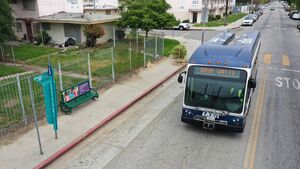Why so few Americans take the bus

A DASH bus travelling through the Watts neighborhood of Los Angeles, California. According to the most recent U.S. Census Bureau, just 3.1% of American adults used public transport to get to work. Picture: AFP via Getty Images
There’s a line in the 1994 film where Sandra Bullock, white-knuckled behind the wheel of a hijacked Los Angeles city bus, tries to keep it from dropping below 50 miles per hour – or it’ll explode. And as she swerves through LA traffic, she shouts her immortal line: “I’m not even supposed to be here!” That quote returned to me recently after I had sat for an hour on the 217 bus heading east through West Hollywood. There were no ticking bombs on board – unless you counted some of the passengers – including a haunted-looking pale-skinned man in a negligee, a Hispanic man with a small dog loudly sucking the sugary remains of donuts off his fingers, a scowling homeless person of indeterminate sex and dirt accompanied by half of downtown L.A. stuffed into a stroller and a fierce black woman shouting expletives at an invisible companion while dragging a suitcase through anything that got in her way. That was just for the first few stops.
This is what public transport in Los Angeles can feel like: an immersive, slow-burning disaster movie – or a safari, where the animals get on and off the ride and wander about, while the tourists do their best to pretend it isn’t happening and the unfazed driver stoically keeps on driving, safely ensconced in his plastic protected cabin.
According to the U.S. Census Bureau, just 3.1% of American adults used public transport to get to work in 2022, down from 5% in 2019. As a recent article pointed out, the issue isn’t just infrastructure. Behavioural scientist Ariella Kristal noted that most people won’t switch their commuting habits unless they’re changing jobs or homes.
As someone who once chaired the Mayo branch of the Irish Green Party, I spent years promoting the virtues of public transport. In Europe, it’s a no-brainer. Politicians, CEOs, nurses and pensioners alike use buses, trams and trains without a second thought. Our Green policies are built on a vision of the public adopting efficient, inclusive, low-emission transit built on an integrated public transport system, yet I think we and Bloomberg are forgetting one vital element – customer experience. For this to work, taking the bus must be a safe, attractive and stress-free option for all users, because when it isn’t – as in the U.S., particularly in sprawling cities like L.A. – the reality is very different.
While Margaret Thatcher is often (unfairly) associated with the quote: “A man who, beyond the age of 26, finds himself on a bus, can count himself as a failure”, she could have been speaking of Los Angeles, where there’s a similar middle-class social stigma – as taking the bus often reads as failure, not frugality. But at its root there is more than just snobbery, because ask anyone as to why more people don’t take the bus here and their answer is simple: it’s usually a horrible experience.
One evening, returning from a meeting at SAG-AFTRA headquarters, I boarded the 217 near the La Brea Tar Pits. From my journey’s inception, it was less commute, more performance art meets psychological test.
Directly in front of me sat a squat Hispanic man in his fifties, leaning on the shoulder of a stoney-faced woman with hollow-cheeks, in a top with a ragged hem. He cradled a small dog on his lap while eating pastries slowly extracted from a cardboard box as if he was test-driving a new hand. Between bites, he’d fall asleep and she’d nudge him upright when his box threatened to fall over. His faded duffel bag with a broken zip half-blocked the aisle. No one blinked.
When he would finally get off – revealing a skateboard hidden in his bag – the woman suddenly comes alive and launches into a rapid-fire monologue at a young mother with a baby, who had made the mistake of eye contact. “Can you believe him?” she exclaimed and then reverted into a Spanish diatribe. Her listener just nodded along, praying it wouldn’t escalate.
Further up the aisle, a bearded man in a wheelchair boarded with his younger companion – a thin jittery man in a sheer negligee, white-dyed hair, smeared makeup, earrings, and a darting stare. He spoke in disjointed bursts, barely coherent, while scanning the bus like a paranoid magpie.
Opposite them, an angry-looking homeless person sat within a halo of vacant seats, clutching a large misshapen bag of his belongings, while emitting a truly awful smell which erupted a wave of gaging reflexes which rippled through the bus when he got up to leave. The driver left open the door after him, as he continued the journey and a welcoming blast of evening breeze purged our air.
Around me, tired workers slumped into seats and phones blared Spanish-speaking YouTube videos with no headphones. No one complained – or rather no one paid any notice. One older women seemed oblivious that her video call with her daughter could be heard back in Crossmolina, which somehow included the repeated sound of a musical instrument being hammered into submission by an angry goblin – or maybe a large animal was repeatedly sitting on it. Either way, my headphones seemed to make the screeching noise worse and for the first time ever I wished my tinnitus was worse. Thankfully she got off before I wished for deafness.
A few stops earlier, as we turned onto Hollywood Boulevard, a woman with deep brown skin and wild hair burst in through the back doors, mid-argument with an imaginary foe. She didn’t pay – no one expected her to. She screamed her way down the bus, yanking a suitcase that got stuck in the donut man’s gear. She roared at him. He blinked slowly. She pulled at her bag. “God, she’s crazy,” muttered the negligee man. The woman paused and spun around, “you say that again! And I will f**k you up”. The bus held its breath…as the man in the wheelchair emitted a throttled yelp. She yanked her bag forward and glared at an empty space between two seats – “and I told you bitch to keep out of this” she hissed, before exiting the back doors mid-sentence. The 217 collectively exhaled.
Here’s something that surprises European visitors: most people on LA buses don’t pay. Not just the visibly homeless – although they board pushing their cartful-sized belongings and head straight to their chosen seat without even glancing at the fare machine — but also many ‘ordinary’ passengers, young and old. The rear doors are technically ‘exit only’ but people enter through them constantly, especially in busy areas. No payment. No apology. The drivers rarely bother to intervene. You’ll see one passenger diligently paying full fare, only to be followed by four others who waltz past like it’s a charity service.
The result? An unspoken rule: pay if you want. Or don’t. Just try not to draw attention to yourself. Don’t interfere, don’t make eye contact.
Not all homeless people are mentally unwell but seemingly most insane people are homeless and they all seem to take the bus, especially those routes that originate downtown, near Skid Row – a neighbourhood well known for its extremely high concentration of homeless people, many of whom live in tents, makeshift shelters or on the street. It’s one of the most visible and entrenched examples of urban poverty in the United States and the bus journey provides temporary relief from there, a place to sleep and a free way to get around the city to other locations.
It is easy to see why many do not want to take public transport here, as few need the stress. Yet, in a way the bus is just one of those open jeeps from Jurassic Park: the fences are down, the dinosaurs are loose and no one – not even the driver – is fully in control. Because, this is usually as close as a middle-class person will likely get for more than a few minutes, to someone they would otherwise hurry by on the street – or never meet if taking the ubiquitous car. Rather than fix a societal problem, Los Angeles chooses not to see it, but it cannot be avoided on the bus.
And as I get off the 217 at my stop, I whisper, “I’m not even supposed to be here” but then after a few steps think again: “But I’m glad I was.”






